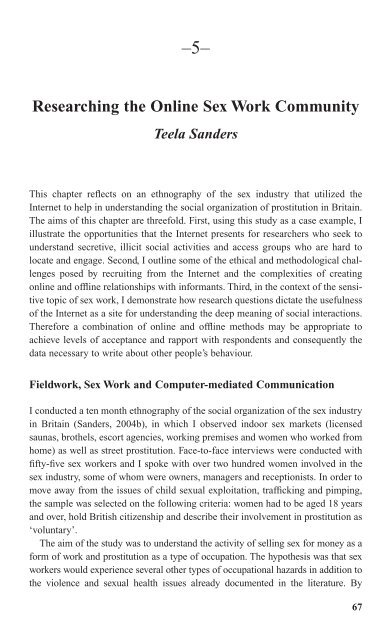Virtual Methods
Virtual Methods
Virtual Methods
Create successful ePaper yourself
Turn your PDF publications into a flip-book with our unique Google optimized e-Paper software.
–5–<br />
Researching the Online Sex Work Community<br />
Teela Sanders<br />
This chapter reflects on an ethnography of the sex industry that utilized the<br />
Internet to help in understanding the social organization of prostitution in Britain.<br />
The aims of this chapter are threefold. First, using this study as a case example, I<br />
illustrate the opportunities that the Internet presents for researchers who seek to<br />
understand secretive, illicit social activities and access groups who are hard to<br />
locate and engage. Second, I outline some of the ethical and methodological challenges<br />
posed by recruiting from the Internet and the complexities of creating<br />
online and offline relationships with informants. Third, in the context of the sensitive<br />
topic of sex work, I demonstrate how research questions dictate the usefulness<br />
of the Internet as a site for understanding the deep meaning of social interactions.<br />
Therefore a combination of online and offline methods may be appropriate to<br />
achieve levels of acceptance and rapport with respondents and consequently the<br />
data necessary to write about other people’s behaviour.<br />
Fieldwork, Sex Work and Computer-mediated Communication<br />
I conducted a ten month ethnography of the social organization of the sex industry<br />
in Britain (Sanders, 2004b), in which I observed indoor sex markets (licensed<br />
saunas, brothels, escort agencies, working premises and women who worked from<br />
home) as well as street prostitution. Face-to-face interviews were conducted with<br />
fifty-five sex workers and I spoke with over two hundred women involved in the<br />
sex industry, some of whom were owners, managers and receptionists. In order to<br />
move away from the issues of child sexual exploitation, trafficking and pimping,<br />
the sample was selected on the following criteria: women had to be aged 18 years<br />
and over, hold British citizenship and describe their involvement in prostitution as<br />
‘voluntary’.<br />
The aim of the study was to understand the activity of selling sex for money as a<br />
form of work and prostitution as a type of occupation. The hypothesis was that sex<br />
workers would experience several other types of occupational hazards in addition to<br />
the violence and sexual health issues already documented in the literature. By<br />
67



